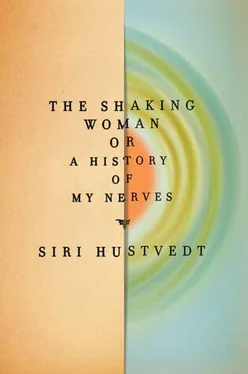Pierre Janet, a philosopher and neurologist who was a younger colleague of Charcot’s went further than his mentor in exploring the psychic aspects of hysteria. He maintained, as Charcot had, that hysteria could begin with a shock — a carriage accident, for example — and that the person need not have been physically hurt in the crash. It was enough, Janet argued, for him to have the idea that “the wheel passed over his leg” for the limb to become paralyzed. 17Janet was the first to use the word dissociation in relation to hysteria. He defined it as a division among “systems of ideas and functions that constitute the personality.” 18Ideas, for Janet, weren’t disembodied thoughts but were part of psychobiological systems that included emotions, memories, sensations, and behaviors. In a series of lectures Janet delivered at Harvard in 1906, he argued that hysteria was defined by “suggestion,” which was “a too powerful idea that acts on the body in an abnormal way.” 19The horrible idea of the carriage accident becomes dissociated within the person: “Things happen as if an idea, a partial system of thoughts, emancipated itself, became independent and developed itself on its own account. The result is, on the one hand, that it develops far too much, and, on the other hand, that consciousness appears no longer to control it.” 20Hysteria, then, is a systemic divide that allows a renegade part of the self to wander off unguided.
Janet tells the story of Irene, an impoverished young woman of twenty, who watched her beloved mother die a slow, agonizing death from tuberculosis. After weeks of sitting by the sickbed, Irene noticed that her mother had stopped breathing and desperately tried to revive her. During those efforts, her mother’s corpse fell to the floor, and it took all of Irene’s strength to lift the body back onto the bed. After her mother’s funeral, Irene began to relive the death in trances, acting out its horror in great detail or telling it over and over again. After these reenactments, she would return to normal consciousness and behave as if nothing had happened. Irene’s relatives reported that the girl seemed weirdly unconcerned about her mother’s death. Indeed, she seemed to have forgotten about it. Irene herself expressed surprise and asked when and how her mother had died. “There is something I don’t understand,” she said. “Why, loving her as I did, do I not feel more sorrow for her death? I can’t grieve; I feel as if her absence were nothing to me, as if she were traveling and would soon come back.” 21
I was struck by this passage. I wondered if there was a similar blankness in myself. Should I have grieved more for someone I had loved so much? For many months after he died, I dreamed that my father was still alive. I had been wrong about his dying; he wasn’t dead at all. Irene sat by helplessly as her mother died. When my father was dying, I spent hours with him in a chair beside his bed. Oxygen helped him breathe, and he could no longer get out of bed without help. After his lung collapsed, the doctors revived him by drilling a hole into his chest and reinflating the lung. I remember the hole. I remember his gray face in the hospital in Minneapolis, the ugly fluorescent light in the small room, and the groaning old man in the bed next to him behind a curtain. I remember that when my father was able to return to the nursing home, he smiled as he was wheeled into the narrow room and said, “It’s good to be home, even though it’s not really home.” He and I talked a lot in the days before he died, about many things, and as we talked, I kept telling myself to expect his death, to prepare for it. He was eighty-one years old and had lived a long life. People don’t live forever. We all die. I fed myself the usual platitudes, and I thought the stories I told myself worked, but I now think I may have been wrong.
Janet coined the phrase la belle indifférence, which is still used. It is generally understood to be a strange lack of concern about one’s own illness and is specifically connected to conversion disorder or hysteria. An example given in a primer for students studying for the psychiatric boards is illustrative: After his mother dies in his home country, Mexico, a man now living in the United States suddenly goes blind. No physical cause can be located, and he seems oddly unconcerned about the fact that he can’t see. His blithe attitude to a condition so dramatic is a hint that he may be a conversion patient. 22In Irene’s case, the indifference was connected to the traumatic event itself. Was this my problem? Why, loving him as I did, do I not feel more sorrow? Janet would have said that the grief had gone into a hidden part of me. Freud would have understood my problem as an efficient way to protect myself from what I couldn’t acknowledge. The hysterical shaking served a concealing, useful purpose.
And yet, a curious indifference is also seen in neurological patients who have visible lesions in their brains. People with Anton’s syndrome, after suffering some devastating neurological event, such as a stroke, lose their sight but insist that they can see. Anton’s is part of a much broader phenomenon called anosognosia — denial of illness. In his book Altered Egos, Todd Feinberg describes a woman, Lizzy, who had had strokes in both occipital lobes of her brain, where the primary visual cortex is located, and had become totally blind. “She might deny her blindness, and later admit it,” he writes, “but never did she seem to act as if her visual impairment was of any concern. She talked throughout the interview and acted as if she had not a care in the world.” 23Lizzy vacillated between knowing and not knowing that she couldn’t see, but even when she seemed to know, her attitude was consistent. She didn’t appear to care . Two people have gone blind. One person’s visual cortex is intact; the other’s is damaged. One is a psychiatric case, another a neurological one, but both display an uncanny lack of distress about their plight. Is their nonchalance connected? Aren’t they both in some way dissociated from what has happened to them? Could their similar attitudes be considered repression, to use the psychoanalytic term? Is the indifference psychological in the first case but neurological in the second? Of course, not all people who have lesions in their primary visual cortex and go blind deny being blind; only some people. And not all people suffering from conversion disorder have la belle indifférence . But Irene, the fictitious Mexican, Lizzy, and I may have something in common: a grieving problem. Irene was so traumatized by her mother’s death that some fragment of her self repeated the circumstances of that demise over and over again, while another part felt nothing. Did I, too, have a kind of double consciousness — a shuddering person and a cool one?
ABOUT SIX MONTHS AFTER my shaking episode, I gave a lecture at New York Presbyterian Hospital as part of a series of talks in Columbia University’s Program in Narrative Medicine, run by Rita Charon. Charon is a physician who also has a PhD in literature. Her mission is to bring storytelling back to medical practice. Without it, she argues, the reality of a single person’s suffering is lost and medicine suffers. Her distinction between nonstory and story is one of focus: “Nonnarrative knowledge attempts to illuminate the universal by transcending the particular; narrative knowledge, by looking closely at individual human beings grappling with the conditions of life, attempts to illuminate the universals of the human condition by revealing the particular.” 24In my talk, I described my tree-commemoration fit and used three figments — a psychiatrist, a psychoanalyst, and a neurologist — to illustrate how a single paroxysmal event might be construed differently, depending on your field of expertise. Disciplinary lenses inevitably inform perception. There I was giving another speech, this time in front of psychiatrists, psychoanalysts, and doctoral students in literature, and I was telling them about my shuddering. Before the lecture, a thought entered my mind: What if I shake again? At the very beginning, I felt my hands tremble. That was familiar, and I didn’t think much of it. The more I talked, the more I relaxed. I could feel that the audience was listening. My confession about the shakes had a purpose, and everyone seemed to understand it. The talk went well. Some months later, I gave a shorter version of the same speech at a literary seminar in Key West, Florida. Before that second delivery, I had participated in several panels onstage without a quiver.
Читать дальше












